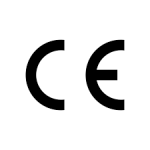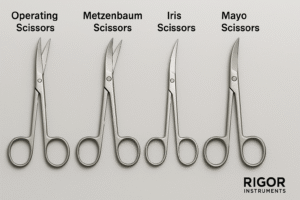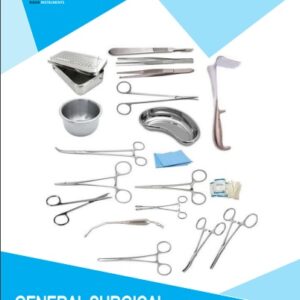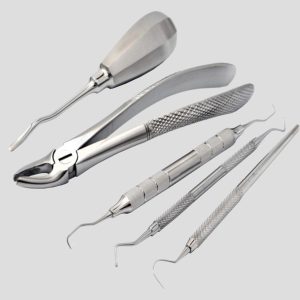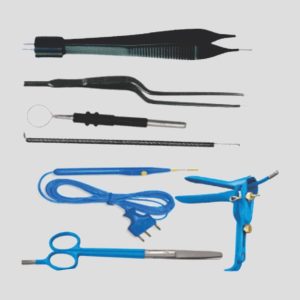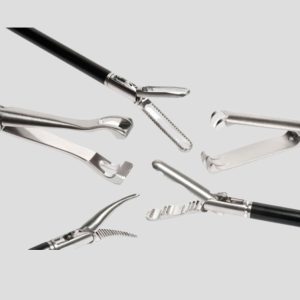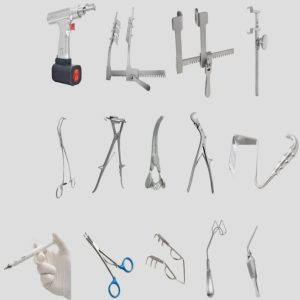How to Choose the Right Surgical Scissor for Your Procedure
Rigor Instruments – Precision Cutting, Perfect Control
Choosing the correct surgical scissor is critical for tissue preservation, cutting accuracy, and surgical success. The right selection depends on the tissue type, depth, and purpose (cutting vs. dissecting).
1. Based on Function
| Type | Best For | Example Scissors |
|---|---|---|
| Dissecting | Blunt tissue separation | Metzenbaum, Mayo (blunt) |
| Cutting | Cutting sutures, gauze, fascia | Mayo (sharp), Suture Scissors |
| Microsurgical | Precision cuts in ophthalmic/neuro | Castroviejo, Vannas |
2. Based on Tissue Type
| Tissue Type | Recommended Scissor | Tip Type |
|---|---|---|
| Delicate tissue | Metzenbaum Scissors | Blunt tips |
| Tough tissue/fascia | Mayo Scissors (Straight/Curved) | Sharp tips |
| Fine/vascular tissue | Iris, Potts, Castroviejo | Fine-point |
| Sutures | Suture Removal, Spencer | Hooked or notched tips |
3. Based on Scissor Tip
Blunt/Blunt: Safe dissection near sensitive structures
Blunt/Sharp: Versatile; some cutting, some dissection
Sharp/Sharp: Precise cutting, especially on fascia and sutures
4. Curved vs. Straight Blades
| Blade Type | Use Case |
|---|---|
| Straight | Surface-level cutting (sutures, gauze) |
| Curved | Deep dissection and visibility around structures |
5. Handle Style & Mechanism
Ring Handle: Standard for general use
Spring Handle: Ideal for microsurgical or ophthalmic work
Double-action: Used in orthopedic and endoscopic scissors
6. Blade Edge Options
| Edge Type | Use Case |
|---|---|
| Smooth | Clean, precise cuts in soft tissue |
| Serrated | Prevents slipping; ideal for tough tissue |
| Super-cut | One razor edge + one micro-serrated edge for superior cutting power |
7. Material & Finish (Rigor Instruments Standard)
AISI 420 Stainless Steel for hardness
Titanium (on request) for lightweight microsurgical scissors
Matte/Satin Finish to reduce glare
Black (Cerakoted) or mirror-polished options for specialty procedures
Quick Reference Examples:
Metzenbaum Curved (Blunt): Ideal for soft tissue dissection
Mayo Straight (Sharp): Great for cutting fascia
Spencer Scissors: Designed for suture removal
Castroviejo Scissors: Microsurgical precision cutting
SuperCut Mayo: Powerful, no-slip cutting in orthopedic procedures
Lets Walk you Through The Final Checking Department of Rigor
Rigor Instruments – Precision You Can Trust
Surgical scissors are critical tools used across every specialty—whether it’s dissecting delicate tissues or cutting tough fascia. Ensuring their quality, performance, and safety is vital for successful outcomes in the operating room. At Rigor Instruments, every pair of scissors undergoes a multi-step inspection to meet international standards like ISO 13485 and CE certification.
Here’s a comprehensive guide on how to check the quality of surgical scissors—useful for hospitals, distributors, and OEM buyers.
1. Visual Inspection
A thorough visual examination is the first step in quality assurance:
Check for surface defects: Look for scratches, pits, dents, or signs of rust.
Blade alignment: The tips should meet precisely, with no visible gap or misalignment.
Symmetry: Both arms of the scissors should be mirror images and open evenly.
2. Blade Sharpness Test
Sharpness directly impacts cutting performance:
Use a latex glove or gauze test: Scissors should cut through smoothly without snagging.
In high-quality scissors like those from Rigor, cutting action should require minimal force.
3. Joint Movement & Tension
The joint (screw or rivet) is the heart of the instrument:
Open and close the scissors 10–15 times. Movement should be smooth and free from resistance or looseness.
No clicking sounds or “wobble” should be felt.
Tension should be appropriate—not too tight or too loose.
4. Material Verification
Most surgical scissors are made from:
AISI 420 (Martensitic Stainless Steel) for sharpness and strength
AISI 316L (Austenitic Stainless Steel) for corrosion resistance
Titanium for microsurgical applications
A magnetism test helps verify the material:
420 steel is mildly magnetic;
316L and titanium are non-magnetic.
5. Corrosion Resistance Test (Optional but Critical)
High-grade scissors should resist corrosion under harsh sterilization cycles:
Soak in 6% Ferric Chloride for 90 minutes, then rinse and inspect.
No discoloration, pitting, or rust should appear.
Rigor Instruments scissors pass internal salt spray and ferric chloride testing.
6. Finish Quality
Scissors should have a consistent and clean surface:
Matte/satin finish: Reduces glare in the OR
Mirror polish: Enhances corrosion resistance and ease of cleaning
Black finish (cerakoted or ebonized): Ideal for laser or microsurgery
Ensure the finish is uniform with no flaking, irregular patches, or discoloration.
7. Blade Type & Serration Check
Smooth edge scissors: Ideal for soft tissue
Serrated edge: Prevents tissue slippage—especially for fascia or tendons
SuperCut blades: Combine a razor edge with micro-serrations for ultimate cutting performance
Run your fingertip (carefully) or a soft cloth along the blade to feel serrations.
8. Marking & Traceability
High-quality instruments will have:
Laser-etched branding (e.g., “RIGOR”)
Lot number or batch code
CE, ISO 13485, or FDA marks (if required)
Poor-quality instruments may have ink markings or inconsistent etching.
9. Packaging Inspection
Check that each scissor is:
Packed in sterile or non-sterile medical-grade pouches
Free from dust or particles inside the pouch
Labeled properly with size, type, and reference number
Rigor Instruments Quality Promise
All Rigor Instruments scissors undergo:
Precision CNC milling & hand-finishing
Electropolishing & passivation
Ultrasonic cleaning & drying
Final QA by ISO-trained inspectors
Whether you’re sourcing for hospitals, distributors, or private-label OEMs, we guarantee reliability, sharpness, and performance.
Need samples or custom QA reports?
Email us at: [email protected]
📞 Call/WhatsApp: +92 303 7759000

